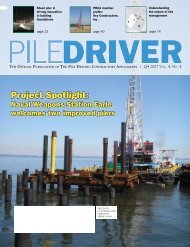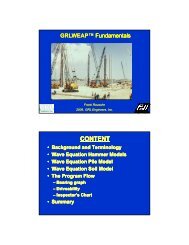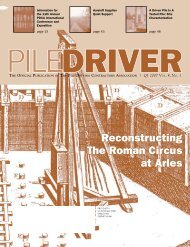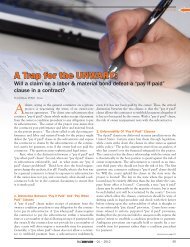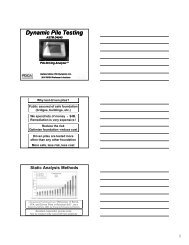Full Issue (17 MB) - Pile Driving Contractors Association
Full Issue (17 MB) - Pile Driving Contractors Association
Full Issue (17 MB) - Pile Driving Contractors Association
Create successful ePaper yourself
Turn your PDF publications into a flip-book with our unique Google optimized e-Paper software.
The Harvey Canal Project:<br />
Saving Time, Saving<br />
Money and Saving Lives<br />
For years, more than 200,000 homes and businesses in<br />
Louisiana’s Jefferson Parish have been at risk. Their<br />
only flood protection from a major canal on the Gulf<br />
Intracoastal Water Way has been a short earthen levee or<br />
bulkheads the property owners built themselves.<br />
“It’s caused us nightmares,” says Giuseppe Miserendino,<br />
executive director of the West Jefferson Levee District.<br />
“After this hurricane season, we won’t have to worry about<br />
it.”<br />
That’s because crews are finishing a $250 million steel<br />
and concrete floodwall along the Harvey Canal that’ll rise<br />
19 feet above land – more than twice as tall as the earthen<br />
levee and far more solid. The floodwall will stretch more<br />
than 3 miles, and besides potentially saving lives, it’s also<br />
been an award-winning lesson in saving time and money.<br />
Building a T-wall<br />
Designs for the Harvey Canal project called for a T-wall<br />
(built like an inverted T). A total of about 30,000 yards of<br />
concrete will be set atop 7,800 steel H-piles, some of which<br />
are as long as 140 feet. To install piles that long, contractors<br />
would normally get the pile delivered in two pieces, install<br />
the bottom half, then splice on the top. For this project,<br />
though, that would have been too expensive and taken too<br />
much time.<br />
The crews at Cajun Deep Foundations, a subsidiary of<br />
specialty contractor Cajun Industries, developed a second<br />
option. They asked Nucor-Yamato Steel to roll the piles<br />
at full length. All told, more than 1 million linear feet of<br />
HP14 x 89 piles will be used. About 900 piles still needed to<br />
be spliced, but with a project that required a total of 7,800<br />
piles, Cajun’s idea saved nearly $8 million in splicing costs<br />
alone, says Chris Thompson, a Cajun project manager. And<br />
that doesn’t include the savings from getting the work done<br />
so much quicker.<br />
“That amount,” Thompson says, “far exceeds the $8<br />
million saved from splicing.”<br />
The solution helped the Army Corps of Engineers sus-<br />
• Q4 • 2009<br />
71






